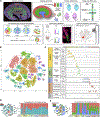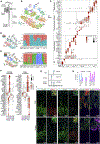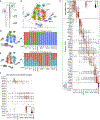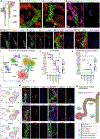Single-Cell Profiling Reveals Sex, Lineage, and Regional Diversity in the Mouse Kidney
- PMID: 31689386
- PMCID: PMC6948019
- DOI: 10.1016/j.devcel.2019.10.005
Single-Cell Profiling Reveals Sex, Lineage, and Regional Diversity in the Mouse Kidney
Abstract
Chronic kidney disease affects 10% of the population with notable differences in ethnic and sex-related susceptibility to kidney injury and disease. Kidney dysfunction leads to significant morbidity and mortality and chronic disease in other organ systems. A mouse-organ-centered understanding underlies rapid progress in human disease modeling and cellular approaches to repair damaged systems. To enhance an understanding of the mammalian kidney, we combined anatomy-guided single-cell RNA sequencing of the adult male and female mouse kidney with in situ expression studies and cell lineage tracing. These studies reveal cell diversity and marked sex differences, distinct organization and cell composition of nephrons dependent on the time of nephron specification, and lineage convergence, in which contiguous functionally related cell types are specified from nephron and collecting system progenitor populations. A searchable database, Kidney Cell Explorer (https://cello.shinyapps.io/kidneycellexplorer/), enables gene-cell relationships to be viewed in the anatomical framework of the kidney.
Keywords: collecting system; kidney; lineage convergence; nephron; scRNA-Seq profiling; sex differences.
Copyright © 2019 Elsevier Inc. All rights reserved.
Conflict of interest statement
Declaration of competing interests:
The authors declare no conflict of interest.
Figures






Comment in
-
Diving Deep into the Adult Mouse Kidney.Dev Cell. 2019 Nov 4;51(3):293-294. doi: 10.1016/j.devcel.2019.10.015. Dev Cell. 2019. PMID: 31689383 Free PMC article.
References
-
- Bertram JF, Douglas-Denton RN, Diouf B, Hughson MD and Hoy WE (2011). Human nephron number: implications for health and disease. Pediatr. Nephrol 26, 1529–1533. - PubMed
Publication types
MeSH terms
Grants and funding
LinkOut - more resources
Full Text Sources
Other Literature Sources
Molecular Biology Databases

